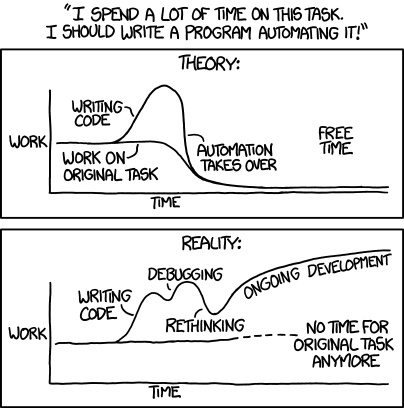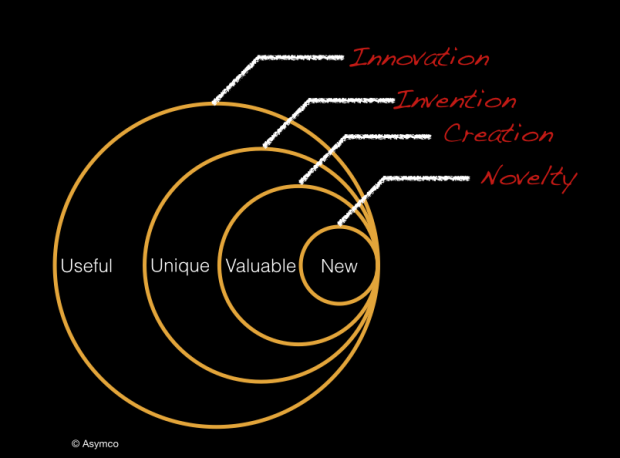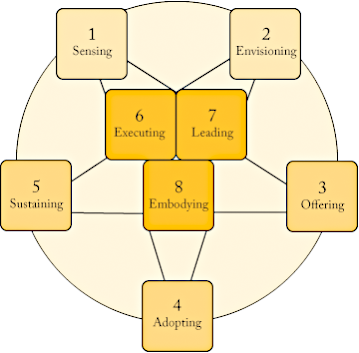Innovation is about finding a better way of doing something. Like many of the new development buzzwords (which many of them are over-used on many business documents), the concept of innovation originates from the world of business. It refers to the generation of new products through the process of creative entrepreneurship, putting it into production, and diffusing it more widely through increased sales. Innovation can be viewed as t he application of better solutions that meet new requirements, in-articulated needs, or existing market needs. This is accomplished through more effective products, processes, services, technologies, or ideas that are readily available to markets, governments and society. The term innovation can be defined as something original and, as a consequence, new, that “breaks into” the market or society.
Innoveracy: Misunderstanding Innovation article points out that there is a form of ignorance which seems to be universal: the inability to understand the concept and role of innovation. The way this is exhibited is in the misuse of the term and the inability to discern the difference between novelty, creation, invention and innovation. The result is a failure to understand the causes of success and failure in business and hence the conditions that lead to economic growth. The definition of innovation is easy to find but it seems to be hard to understand. Here is a simple taxonomy of related activities that put innovation in context:
- Novelty: Something new
- Creation: Something new and valuable
- Invention: Something new, having potential value through utility
- Innovation: Something new and uniquely useful
The taxonomy is illustrated with the following diagram.
The differences are also evident in the mechanisms that exist to protect the works: Novelties are usually not protectable, Creations are protected by copyright or trademark, Inventions can be protected for a limited time through patents (or kept secret) and Innovations can be protected through market competition but are not defensible through legal means.
Innovation is a lot of talked about nowdays as essential to businesses to do. Is innovation essential for development work? article tells that innovation has become central to the way development organisations go about their work. In November 2011, Bill Gates told the G20 that innovation was the key to development. Donors increasingly stress innovation as a key condition for funding, and many civil society organisations emphasise that innovation is central to the work they do.
Some innovation ideas are pretty simple, and some are much more complicated and even sound crazy when heard first. The is place for crazy sounding ideas: venture capitalists are gravely concerned that the tech startups they’re investing in just aren’t crazy enough:
Not all development problems require new solutions, sometimes you just need to use old things in a slightly new way. Development innovations may involve devising technology (such as a nanotech water treatment kit), creating a new approach (such as microfinance), finding a better way of delivering public services (such as one-stop egovernment service centres), identifying ways of working with communities (such as participation), or generating a management technique (such as organisation learning).
Theorists of innovation identify innovation itself as a brief moment of creativity, to be followed by the main routine work of producing and selling the innovation. When it comes to development, things are more complicated. Innovation needs to be viewed as tool, not master. Innovation is a process, not a one time event. Genuine innovation is valuable but rare.
There are many views on the innovation and innvation process. I try to collect together there some views I have found on-line. Hopefully they help you more than confuze. Managing complexity and reducing risk article has this drawing which I think pretty well describes innovation as done in product development:
8 essential practices of successful innovation from The Innovator’s Way shows essential practices in innovation process. Those practices are all integrated into a non-sequential, coherent whole and style in the person of the innovator.
In the IT work there is lots of work where a little thinking can be a source of innovation. Automating IT processes can be a huge time saver or it can fail depending on situation. XKCD comic strip Automation as illustrates this:

System integration is a critical element in project design article has an interesting project cost influence graphic. The recommendation is to involve a system integrator early in project design to help ensure high-quality projects that satisfy project requirements. Of course this article tries to market system integration services, but has also valid points to consider.
Core Contributor Loop (CTTDC) from Art Journal blog posting Blog Is The New Black tries to link inventing an idea to theory of entrepreneurship. It is essential to tune the engine by making improvements in product, marketing, code, design and operations.






5,690 Comments
Tomi Engdahl says:
https://scitechdaily.com/scientists-finally-confirm-crazy-vitamin-b1-theory-from-1958/
Tomi Engdahl says:
https://fortune.com/well/2025/04/22/microplastics-pollution-health-safety-laundry-clothing-earth-day/
Tomi Engdahl says:
Fyysikot: 69 % maailmankaikkeudesta on pelkkää satua – Sitä ei ole olemassa, vaikka kaikki luulevat niin: Einstein oli oikeassa taas tuhannennen kerran
Pimeää energiaa ei olekaan olemassa, uusiseelantilainen fyysikkoryhmä sanoo. Heidän mukaansa vallitseva kosmologinen teoria on väärä.
https://www.tekniikkatalous.fi/uutiset/fyysikot-69-maailmankaikkeudesta-on-pelkkaa-satua-sita-ei-ole-olemassa-vaikka-kaikki-luulevat-niin-einstein-oli-oikeassa-taas-tuhannennen-kerran/aa09ac3a-0e38-48eb-9c37-d477b58e903b
Tomi Engdahl says:
Uskomaton läpimurto: Teleportaatiosta totta
Tutkijat saavuttivat jopa 10 000-kertaisen kasvun kvanttien teleportaatiossa uudella järjestelmällä.
https://www.iltalehti.fi/ulkomaat/a/cafa14b7-3268-49ea-b3ee-9dc46459216f
Tomi Engdahl says:
45 years ago, Carl Sagan beautifully explained the fourth dimension with just an apple
Sagan was the Mister Rogers of complex scientific concepts.
https://www.upworthy.com/carl-sagan-4d-ex1
Tomi Engdahl says:
https://www.earth.com/news/scientists-finally-learn-what-makes-plants-roots-grow-faster-and-stronger-autophagy/
Tomi Engdahl says:
https://www.allrecipes.com/the-ten-riskiest-foods-to-eat-according-to-recall-data-2025-11731640
Tomi Engdahl says:
https://thedebrief.org/a-centuries-old-impossible-equation-once-considered-unsolvable-finally-has-a-solution/
Tomi Engdahl says:
https://futurism.com/neoscope/single-injection-prevent-allergic-reactions
Tomi Engdahl says:
Tätä ei ole koskaan ennen tapahtunut – Nyt onnistui 222 v jälkeen: Kemistit repivät rikki strategisten metallien ikiaikaisen säännön – 15x harvinaisempi temppu kuin uusi alkuaine
4f-orbitaalit tekivät tempun, jota kemistit olivat ehtineet odottaa vuosikymmeniä, jopa vuosisatoja.
https://www.tekniikkatalous.fi/uutiset/tata-ei-ole-koskaan-ennen-tapahtunut-nyt-onnistui-222-v-jalkeen-kemistit-repivat-rikki-strategisten-metallien-ikiaikaisen-saannon-15x-harvinaisempi-temppu-kuin-uusi-alkuaine/3c5396aa-5007-4192-8e0f-bf5ebcb24ce9
Kemistit ovat ensimmäistä kertaa koskaan havainneet 4f-tyyppisten atomiorbitaalien osallistuvan kemiallisiin sidoksiin täysimääräisesti. Eric Schelterin johtama tutkimusryhmä Yhdysvalloista havaitsi tämän ilmiön tarkastellessaan, miten eräs monimutkainen cerium-metallin kompleksiyhdiste reagoi, uutisoi Chemical & Enginineering News.
Tomi Engdahl says:
https://www.livenowfox.com/news/antarctica-ice-sheet-growth
Tomi Engdahl says:
Mushrooms may ‘talk’ to one another with up to 50 words
Electrical signals could resemble conversations between fungi
https://www.science.org/content/article/mushrooms-may-talk-one-another-50-words
Tomi Engdahl says:
The great brain clearance and dementia debate
An established theory for how good sleep reduces a person’s risk of neurodegenerative disease has been called into question. The ensuing argument could have enormous consequences for the treatment of Alzheimer’s disease.
https://www.nature.com/articles/d41586-025-00962-y
Tomi Engdahl says:
Nothing is stronger than quantum connections – and now we know why
The mathematics of graphs has helped reveal a principle that limits the strength of quantum correlations – and explains why physicists have never measured any stronger connections in some post-quantum realm
https://www.newscientist.com/article/2479093-nothing-is-stronger-than-quantum-connections-and-now-we-know-why/
Tomi Engdahl says:
Silicon-free microprocessor technology unveiled, 40% faster than Intel’s top chips
Researchers have unveiled a silicon-free microprocessor technology that could be the future of microprocessors and have global implications.
Read more: https://www.tweaktown.com/news/105010/silicon-free-microprocessor-technology-unveiled-40-faster-than-intels-top-chips/index.html
Tomi Engdahl says:
US-German firms unveil silicon battery that charges fast and retains 80% capacity after 1,000+ cycles. https://link.ie.social/aAgBqu
Tomi Engdahl says:
Low-quality papers are surging by exploiting public data sets and AI
Paper mills are also likely contributing to “false discoveries”
https://www.science.org/content/article/low-quality-papers-are-surging-exploiting-public-data-sets-and-ai
Last year, Matt Spick began to notice oddly similar papers flooding in for peer review at Scientific Reports, where he is an associate editor. He smelled a rat. The papers all drew on a publicly available U.S. data set: the National Health and Nutrition Examination Survey (NHANES), which through health exams, blood tests, and interviews has collected dietary information and other health-related measurements from more than 130,000 people. “I was getting so many nearly identical papers—one a day, sometimes even two a day,” says Spick, a statistician at the University of Surrey.
What he was seeing at his one journal is part of a larger problem, Spick has discovered. In recent years, there has been a drastic surge in poor-quality papers using NHANES, possibly spearheaded by illicit moneymaking enterprises known as paper mills and facilitated by the use of artificial intelligence (AI)-generated text, he and colleagues reported in PLOS Biology last week. The finding suggests large public health data sets are ripe for exploitation, they say.
Tomi Engdahl says:
Hidden source of clean energy could power Earth for 170,000 years
A natural gas could be a key component of climate mitigation, scientists say.
https://abcnews.go.com/US/hidden-source-clean-energy-power-earth-170000-years/story?id=121835166
Tomi Engdahl says:
https://www.science.org/content/article/mushrooms-may-talk-one-another-50-words
Tomi Engdahl says:
They Twisted Light on Gold – And What They Saw Blew Their Minds
https://scitechdaily.com/they-twisted-light-on-gold-and-what-they-saw-blew-their-minds/
Scientists in Germany have crafted “skyrmion bags” of light—complex vortex-like structures—on the surface of gold by cleverly manipulating how laser beams interact with nano-etched patterns.
Tomi Engdahl says:
https://www.ecoticias.com/en/confirmed-light-transformed-into-supersolid/12047/
Tomi Engdahl says:
The ‘solar cells in reverse’ that can generate power at night
New semiconductor devices could supplement solar cells by making electricity when the Sun isn’t shining.
https://www.nature.com/articles/d42473-024-00483-8
Tomi Engdahl says:
https://www.zdnet.com/home-and-office/i-tested-a-200-thermal-camera-to-check-my-gcfi-breaker-and-its-very-accurate/
Tomi Engdahl says:
https://www.earth.com/news/dark-photon-theory-casts-doubt-on-double-slit-experiment-quantum-light-interference-pattern/
Tomi Engdahl says:
Scientists discover quantum computing in the brain
Something extraordinary happens when many tryptophan molecules act together in highly ordered protein structures.
https://www.thebrighterside.news/post/scientists-discover-quantum-computing-in-the-brain/
Tomi Engdahl says:
https://shepherdsdream.com/blog/sleep-healthy-living/frequency-of-fabric/
Tomi Engdahl says:
Scientists turn lead into gold for 1st time, but only for a split second
The Large Hadron Collider created 89,000 gold atoms per second.
https://abcnews.go.com/Technology/scientists-turn-lead-gold-1st-time-split/story?id=121762241
In a breakthrough that would make medieval alchemists envious, scientists at Europe’s Large Hadron Collider have successfully transformed lead into gold, producing 89,000 atoms per second.
Tomi Engdahl says:
https://www.earth.com/news/scientists-discover-a-better-way-for-kids-to-learn-math/
Tomi Engdahl says:
https://scitechdaily.com/optical-rotatum-harvard-scientists-discover-new-structure-of-light/
Tomi Engdahl says:
Scientists Think They’ve Found the Region of the Brain That Regulates Conscious Perception
A new experiment suggests that the thalamus plays a key role in humans becoming consciously aware of stimuli their brain receives.
https://www.wired.com/story/scientists-think-theyve-found-the-brain-region-that-regulates-conscious-perception/
Tomi Engdahl says:
https://scitechdaily.com/gravity-defying-breakthrough-floating-sensor-unmasks-dark-energys-secrets/
Tomi Engdahl says:
https://scitechdaily.com/quantum-code-cracked-scientists-solve-20-year-puzzle-behind-entanglement-purity/
Tomi Engdahl says:
https://farmingdale-observer.com/2025/05/04/with-1-terabit-per-second-over-750-miles-china-has-solved-the-biggest-dilemma-in-telecom-until-now-companies-had-to-choose-between-speed-and-security/
Tomi Engdahl says:
No rare metals, no fire risk! This new sodium-ion battery charges fast and lasts thousands of cycles. https://link.ie.social/BaDHx2
Tomi Engdahl says:
Kiinalaistutkijat kehittivät piilolinssin, jolla näkee pimeässä
https://etn.fi/index.php/13-news/17563-kiinalaistutkijat-kehittivaet-piilolinssin-jolla-naekee-pimeaessae
Kiinalaiset tutkijat ovat onnistuneet kehittämään maailman ensimmäisen piilolinssin, jonka avulla ihminen voi nähdä pimeässä – ainakin tietyissä olosuhteissa. Innovaatio perustuu infrapunavaloon ja sen muuntamiseen näkyväksi valoksi silmälle.
Tutkimuksen takana on Kiinan tiede- ja teknologiayliopiston (University of Science and Technology of China, USTC) tiimi, jota johtivat professorit Xue Tian ja Ma Yuqian. Tulokset julkaistiin arvostetussa Cell-tiedejulkaisussa ja ovat herättäneet laajaa kansainvälistä kiinnostusta.
Ihmisen silmä näkee normaalisti vain näkyvän valon alueella, jonka aallonpituudet ovat noin 380-740 nanometriä. Tämän alueen ulkopuolelle jäävä infrapunavalo – jota on runsaasti esimerkiksi auringonlaskun jälkeen tai infrapunavalaistuissa tiloissa – on silmälle täysin näkymätöntä.
Uudet piilolinssit, joita kutsutaan upconversion- eli ylösmuuntaviksi linsseiksi sisältävät nanomateriaaleja, jotka muuntavat infrapunavalon näkyväksi. Näin käyttäjä voi havaita ympäristössä olevia yksityiskohtia, joita paljaalla silmällä ei voi nähdä.
Vaikka otsikon lupaus “näkemisestä pimeässä” pitää paikkansa tietyin ehdoin, kyse ei ole siitä, että linssit loisivat näkyvyyttä täydellisessä pimeydessä.
Tomi Engdahl says:
US scientists simulate real-time movement of 24,000 electrons to study quantum behavior in materials. https://link.ie.social/B08TLC
Tomi Engdahl says:
Kodak and Xerox are examples of not future thinking/future proofing. Both companies developed or help develop the technology that would eventually kill them.
Xerox had a windows style os long before Microsoft but the high ups didn’t see the value and was only used for internal use.
It is like Xerox PARC development created a computer that used windows and had a mouse to control them but the management thought their future was in photocopiers.
Steve jobs and Bill Gates Both Visited the facility.
Digital Camera tech wasn’t ready for the mainstream back in 1975. The main advantage of digital photos is that you can edit them almost magically through software that is common today, but would have needed a mainframe in the 1970s.
But they didn’t shelve it. This is bullshit. They went on to lead the field in digital photography with their digital back pieces in the 1990s. It was THEN they decided to focus on film.
Mathias Dybvik for real, they even came out with some of the first consumer digital cameras
Neil Caulfield And THEN, after all was lost in the consumer space, they had a board meeting about what to do with digital medical imaging.
“Digital medical imaging? That will never catch on”
And so they repeated their failure from the retail space. I spoke to one of the guys from that meeting.
Tomi Engdahl says:
Apple Used China to Make a Profit. What China Got in Return Is Scarier.
In “Apple in China,” Patrick McGee argues that by training an army of manufacturers in a “ruthless authoritarian state,” the company has created an existential vulnerability for the entire world.
https://www.nytimes.com/2025/05/15/books/review/apple-in-china-patrick-mcgee.html?smid=nytcore-ios-share&referringSource=articleShare&fbclid=IwZXh0bgNhZW0CMTEAAR5wqUew3zwXuvdzNeFcVd0NCWvsjwuV7xTjMEuFtKeIrgazO5qkjWC3JGnHfQ_aem_P9DYR1aSTS64gSj8SuoqBg
Tomi Engdahl says:
The debate of brushing tooths is finally over. Read more: https://trib.al/kVavacR
Tomi Engdahl says:
https://hackaday.com/2025/05/21/big-chemistry-fuel-ethanol/
Tomi Engdahl says:
In October 2024, Japanese scientists began human trials of TRG-035, a drug designed to regenerate teeth by inhibiting the USAG-1 protein. Early animal studies demonstrated successful tooth regrowth, and current trials at Kyoto University Hospital involve adults missing at least one tooth. If proven effective, this treatment could become a natural alternative to dentures and implants by 2030.
For more content like this please visit: https://link.ie.social/ByvVoN
#ToothRegeneration #DentalInnovation #KyotoUniversity #TRG035 #RegenerativeMedicine
Tomi Engdahl says:
From Apple CEO Tim Cook to Vogue editor-in-chief Anna Wintour, successful people across industries are known for being early risers. But does waking up at 4 a.m. every morning actually improve productivity? Research suggests that the answer isn’t quite so simple. https://trib.al/2UtzAUz
Tomi Engdahl says:
https://hackaday.com/2025/05/26/mouse-model-suggests-starch-based-plastics-are-still-bad-for-you/
Tomi Engdahl says:
https://etn.fi/index.php/13-news/17579-laepimurto-akkuteknologiassa-litiumionien-liike-paranee-30-prosenttia
Tomi Engdahl says:
https://www.newsweek.com/harvard-hkust-china-college-international-students-offer-2076257#Echobox=1747996409
Tomi Engdahl says:
https://etn.fi/index.php/13-news/17589-merkittaevae-parannus-litium-metalliakuissa
Tomi Engdahl says:
Bill Gates says Warren Buffett taught him to value free time: Filling ‘every minute of your schedule’ doesn’t make you more serious
https://www.cnbc.com/2023/07/09/bill-gates-says-warren-buffett-taught-him-how-to-value-free-time.html?utm_campaign=trueanthem&utm_content=makeit&utm_medium=social&utm_source=facebook&fbclid=IwZXh0bgNhZW0CMTEAAR645caCVmxjD5p0cvQPLb4LPICPa4qmtwolzlQTFbb8CZMQ1–Z6KtlVD48BA_aem_ilapaKhEXw9WIbYTn_eWaw
Tomi Engdahl says:
Shannon Cuthrell / IEEE Spectrum:
A look at Australian startup Cortical Labs’ CL1, billed as the first code-deployable biological computer, with 115 units shipping this summer at $35K each — World-first biocomputing platform hits the market — Shannon Cuthrell is a freelance journalist covering business and technology.
Human Brain Cells on a Chip for Sale
World-first biocomputing platform hits the market
https://spectrum.ieee.org/biological-computer-for-sale
In a development straight out of science fiction, Australian startup Cortical Labs has released what it calls the world’s first code-deployable biological computer. The CL1, which debuted in March, fuses human brain cells on a silicon chip to process information via sub-millisecond electrical feedback loops.
Designed as a tool for neuroscience and biotech research, the CL1 offers a new way to study how brain cells process and react to stimuli. Unlike conventional silicon-based systems, the hybrid platform uses live human neurons capable of adapting, learning, and responding to external inputs in real time.
“On one view, [the CL1] could be regarded as the first commercially available biomimetic computer, the ultimate in neuromorphic computing that uses real neurons,” says theoretical neuroscientist Karl Friston of University College London. “However, the real gift of this technology is not to computer science. Rather, it’s an enabling technology that allows scientists to perform experiments on a little synthetic brain.”
Tomi Engdahl says:
https://techxplore.com/news/2025-06-smartphones-life-tiny-centers.html
Tomi Engdahl says:
https://farmingdale-observer.com/2025/05/31/iceland-approved-the-4-day-workweek-in-2019-nearly-6-years-later-all-the-predictions-made-by-generation-z-have-come-true/